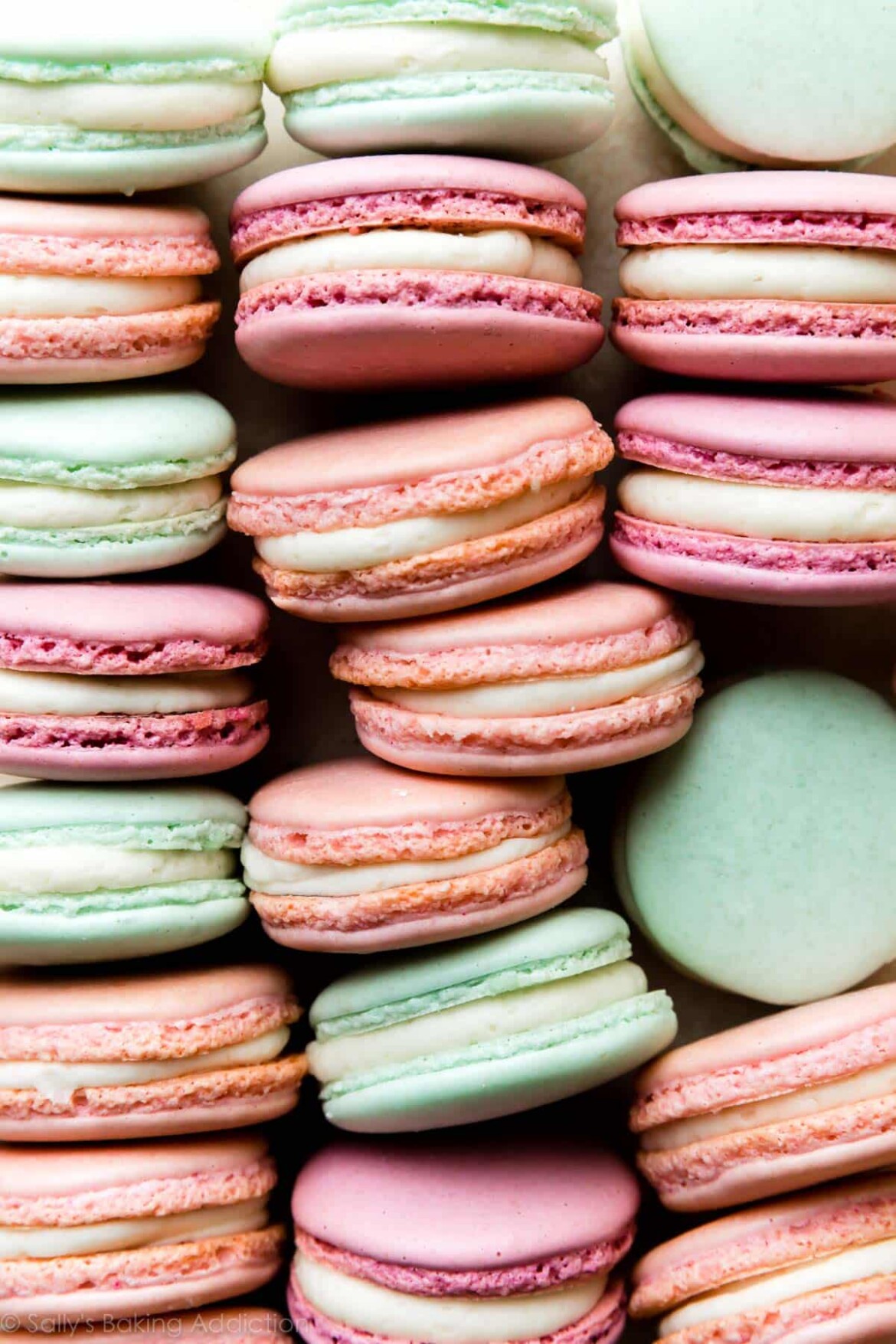I took my 10 year-old daughter Evie to Paris for Spring Break this year with my mother and sister. While there we took a cooking class and learned to make macarons. It was a blast and not as complicated as you might think. Here is a recipe that is very close to what we did. Have fun!
INGREDIENTS:
- 2/3 cup egg whites (usually between 3–4 large egg whites)
- 1/4 teaspoon cream of tartar
- 1/2 teaspoon vanilla extract (optional)
- 3/4 cup superfine sugar
- 1–2 drops gel food coloring
- 1 1/4 cup almond flour
- 1 cup confectioners’ sugar
- Desired macaron filling (some options listed in notes)
DIRECTIONS:
- Wipe down a large glass or metal mixing bowl with lemon juice or vinegar. Add egg whites. Bring to room temperature.
- Line 3 large baking sheets with silicone baking mats or parchment paper. Set aside.
- Add cream of tartar and extract (if using) to egg whites. Using a handheld mixer or stand mixer fitted with a whisk attachment, beat together on medium speed until very soft peaks form. This takes a few minutes of beating. At first the egg white and cream of tartar mixture will be foamy, then the bubbles will begin to tighten and the beaters will leave tracks as the egg whites build volume. Once they begin leaving tracks, you likely have soft peaks. Stop beating.
- Add about 1/3 of the superfine sugar. Beat on medium-high speed for five seconds, then with the mixer continuing to run, add another 1/3 of the sugar. Beat for five seconds, then with the mixer continuing to run, add the remaining sugar. Beat on medium-high speed until stiff glossy peaks form. (This means the whites have stiff, smooth, sharp points in the bowl or on the lifted whisk attachment/beaters. Stiff peaks do not droop down. You can turn the bowl upside down and the egg whites will not move or spill out.)
- Using a rubber spatula, slowly and gently fold the food coloring (if using) into the egg whites.
- Sift the almond flour and confectioners’ sugar together in a large glass or metal mixing bowl. Use a spoon to help work any larger pieces through the sieve.
- Slowly fold the beaten egg whites into the almond flour mixture in three separate additions, folding until combined before adding the next addition.
- After you add all of the egg whites, pay very close attention to the consistency of your macaron batter. Continue folding the batter (which will deflate) until it thins to the consistency of honey. You can also gauge the correct consistency with the “figure 8” test: Let the macaron batter drop from your spatula in a figure 8 form. The figure 8 should take no fewer than 10 seconds to sink back into itself. It’s best to go very slowly so you don’t accidentally over-mix — if the batter collapses in fewer than 10 seconds it will be too thin.
- Spoon the macaron batter into a piping bag fitted with a medium round piping tip, such as Wilton 12, Wilton 1A, or Ateco 806. The batter will be very drippy, so transferring to the piping bag can be messy.
- Holding the piping bag at a 90 degree angle over the baking sheet, pipe batter in 1.5 – 2 inch rounds about 1-2 inches apart on prepared baking sheets. The piped batter will flatten out. Tap the pan a couple times onto the counter to pop any air bubbles, then use a toothpick to pop any remaining air bubbles.
- Let the piped macarons sit out until they are dry and no longer tacky on top, usually 30-60 minutes. This time allows the top to firm up and form a skin, which helps the macarons rise and form their signature ruffly “feet.”
- Meanwhile, preheat the oven to 325°F.
- Bake for 13 minutes. As the macaron shells bake, they should form feet. To test for doneness, lightly touch the top of a macaron with a spoon or your finger (careful, it’s hot). If the macaron seems wobbly, it’s not done and needs another 1-2 minutes. If it seems set, it’s done. Basically, bake until the macarons don’t move around when touched.
- Let the shells cool on the baking sheet for 15 minutes, then transfer to a rack to continue cooling. The macaron shells may stick to the parchment paper/baking sheet if you try to remove them too early.
- Once cooled, the shells are ready to fill and sandwich together. You can spread the filling with a knife or pipe it using the same round tip you used for the macaron batter.
- For filling, the world is your oyster. Try a vanilla buttercream, raspberry jam, salted caramel, or chocolate ganache. Match the shell coloring using gel food coloring to coordinate with your filling flavor of choice.
- You can eat right away or cover and refrigerate 12-24 hours to allow the macarons and flavors to mature. Bring to room temperature before serving. Cover leftover macarons and refrigerate for up to 5 days.

Thank you for this recipe it was nice to have it in English not grams or liters or weight.